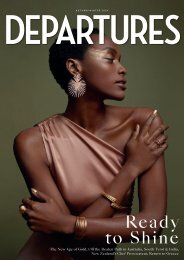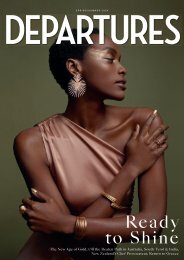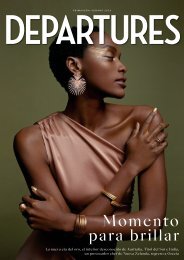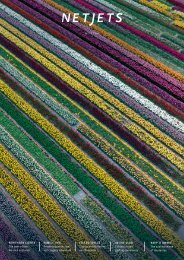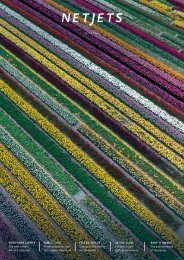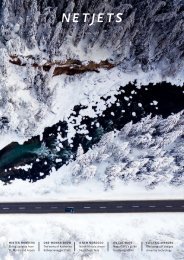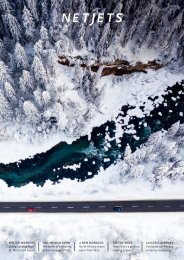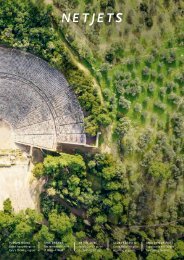You also want an ePaper? Increase the reach of your titles
YUMPU automatically turns print PDFs into web optimized ePapers that Google loves.
artscape<br />
Daniel Birnbaum, who has<br />
taken the creative reins at<br />
VR pioneer Acute Art<br />
Facing page, from top: A<br />
still from Anish Kapoor’s<br />
VR work Into Yourself, Fall,<br />
2018; the artist triying the<br />
VR headset<br />
Previous page: Mona Lisa:<br />
Beyond the Glass, a VR<br />
installation at the Louvre for<br />
the museum’s Leonardo da<br />
Vinci exhibition<br />
E<br />
urope’s most notable exhibition this<br />
year showcases Leonardo da Vinci<br />
at the Louvre, and, perhaps fittingly,<br />
one of the key displays will feature<br />
a device that Leonardo himself might have<br />
dreamed up: A virtual reality headset.<br />
Viewers will be able to explore the<br />
Mona Lisa in extraordinary detail in the<br />
VR experience—benefiting from digital<br />
enhancement to get much closer than the<br />
usual swarming crowds allow, and also<br />
discovering the latest research findings as<br />
well as novel perspectives (viewers can,<br />
among other things, see the reverse side of<br />
the painting) to make a truly new experience<br />
of the world’s best-known work of art.<br />
The Louvre is one of the more conservative<br />
institutions in one of Europe’s most techphobic<br />
countries, so its inaugural foray into<br />
VR is a clear sign, if any were needed, that<br />
VR is here to stay, at least in the art world.<br />
Five years ago, the future of VR wasn’t so<br />
obvious. Like the driverless car, prototypes<br />
existed and there was a vague promise of<br />
future ubiquity. But now, unlike autonomous<br />
vehicles, which are mired in regulatory<br />
red tape and programming details, VR has<br />
fulfilled its promise and sits comfortably<br />
across a range of industries. Architects—and<br />
their clients—have fallen head over heels<br />
for the ability to explore a full building to<br />
scale before the plans are signed off, and<br />
elsewhere it is proving especially popular<br />
as a teaching tool: Trainee surgeons in<br />
England who learn with VR outperform<br />
their 2D-educated peers, and businesses are<br />
increasingly commissioning bespoke training<br />
programs using VR following the theory that<br />
immersive learning is both more effective and<br />
more efficient.<br />
The immersive quality of VR is also a<br />
powerful draw for creative types as well, who<br />
see the potential to unlock a new level of<br />
engagement with their audience. Last month,<br />
Icelandic singer Björk released Vulnicura VR,<br />
a visual reinterpretation of her 2015 album<br />
of the same name that transfers the private<br />
connection between artist and individual<br />
from headphones to headset. “The whole<br />
process has been an improvisation, trying<br />
to keep faith in formats,” she wrote in a<br />
statement, explaining that she wanted to “try<br />
to have courage to grow along with how 360<br />
sound and vision tech was growing”.<br />
Cinema has always been primarily a visual<br />
medium, so its adoption of VR has been relatively<br />
straightforward—and rapid. In 2017, for<br />
instance, director Alejandro González Iñárritu<br />
received a Special Achievement Award Oscar,<br />
the first ever given to a VR film, for his Carne<br />
y Arena, which dramatized the border-crossing<br />
journey from Mexico to the <strong>US</strong>. The Venice<br />
Film Festival—always a bit more adventurous—<br />
has hosted an annual VR section of the festival<br />
on an abandoned island, Lazzaretto Vecchio, for<br />
the last three years. This year’s event included<br />
more than three dozen films, some interactive,<br />
others merely immersive.<br />
French director Céline Tricart, whose<br />
interactive 20-minute film The Key, also about<br />
migrants, won the overall VR competition<br />
this year, sums up the appeal of the medium<br />
for directors: “I believe VR is a first-person<br />
medium. We bring a lot of ourselves in with us:<br />
Our identity, our thoughts, our emotions. It’s<br />
story-living, instead of storytelling.”<br />
The ability to elicit deep empathy makes VR<br />
an especially appealing proposition for artists.<br />
At the very least, it’s a way to get viewers to<br />
give their full attention to works for minutes on<br />
end—a rarity at art museums and galleries.<br />
JOHN SCARISBRICK<br />
68 NetJets







